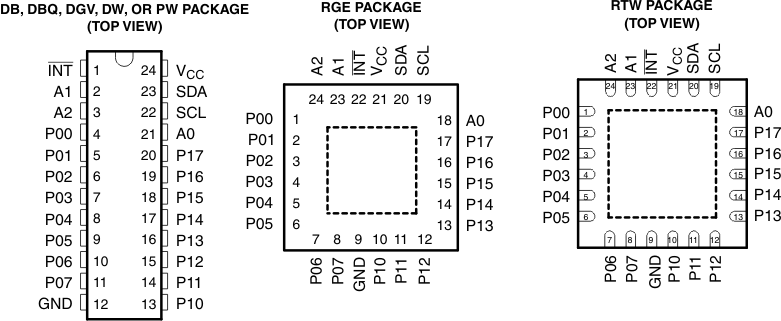-
PCA9535 Remote 16-BIT I2C and SMBus Low-Power I/O Expander With Interrupt Output and Configuration Registers
- 1 Features
- 2 Description
- 3 Revision History
- 4 Description Continued
- 5 Pin Configuration and Functions
- 6 Specifications
- 7 Parameter Measurement Information
- 8 Detailed Description
- 9 Application Information Disclaimer
- 10Power Supply Recommendations
- 11Device and Documentation Support
- 12Mechanical, Packaging, and Orderable Information
- IMPORTANT NOTICE
PCA9535 Remote 16-BIT I2C and SMBus Low-Power I/O Expander With Interrupt Output and Configuration Registers
1 Features
- Low standby-current consumption of 1 μA Max
- I2C to Parallel port expander
- Open-drain active-low interrupt output
- 5-V Tolerant I/O ports
- Compatible with most microcontrollers
- 400-kHz Fast I2C Bus
- Address by three hardware address pins for use of up to eight devices
- Polarity inversion register
- Latched outputs with high-current drive capability for directly driving LEDs
- Latch-up performance exceeds 100 mA Per JESD 78, class II
- ESD Protection exceeds JESD 22
- 2000-V Human-body model (A114-A)
- 1000-V Charged-device model (C101)
2 Description
This 16-bit I/O expander for the two-line bidirectional bus (I2C) is designed for 2.3-V to 5.5-V VCC operation. It provides general-purpose remote I/O expansion for most microcontroller families via the I2C interface [serial clock (SCL), serial data (SDA)].
The PCA9535 consists of two 8-bit Configuration (input or output selection), Input Port, Output Port, and Polarity Inversion (active-high or active-low operation) registers. At power on, the I/Os are configured as inputs. The system master can enable the I/Os as either inputs or outputs by writing to the I/O configuration bits. The data for each input or output is kept in the corresponding Input or Output Port register. The polarity of the Input Port register can be inverted with the Polarity Inversion register. All registers can be read by the system master.
The system master can reset the PCA9535 in the event of a timeout or other improper operation by utilizing the power-on reset feature, which puts the registers in their default state and initializes the I2C/SMBus state machine.
The PCA9535 open-drain interrupt (INT) output is activated when any input state differs from its corresponding Input Port register state and is used to indicate to the system master that an input state has changed.
| PART NUMBER | PACKAGE | BODY SIZE (NOM) |
|---|---|---|
| PCA9535 | SSOP (16) | 6.20 mm × 5.30 mm |
| VQFN (16) | 4.00 mm × 4.00 mm | |
| QFN (16) | 3.00 mm × 3.00 mm |
